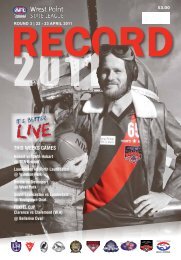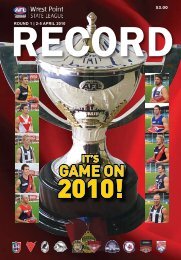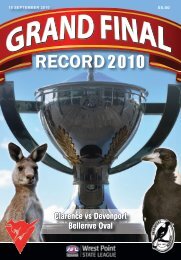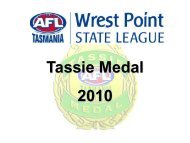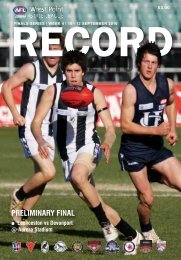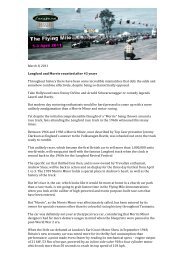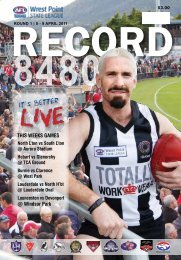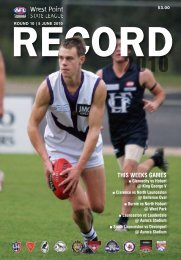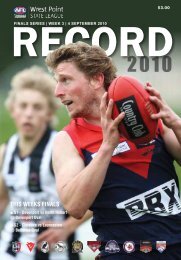THIS WEEKS GAMES
THIS WEEKS GAMES
THIS WEEKS GAMES
Create successful ePaper yourself
Turn your PDF publications into a flip-book with our unique Google optimized e-Paper software.
OUR GREAT GAME | Devonport: rich in football history<br />
The origins of football in Tasmania’s North West coastal region are uncertain. It is possible<br />
that the game was played in mining settlements from the 1870s, brought there from the<br />
mainland, or by miners who travelled west from Launceston.<br />
By 1881, however, the game was definitely being<br />
played in both Latrobe and Devonport with clubs<br />
being formed in both settlements.<br />
The Devonport club was known as Formby, and this<br />
became the Devonport Football Club in 1890. The<br />
Club has, with the exception of the 1900 season,<br />
been a permanent fixture in Tasmanian football ever<br />
since.<br />
A major landmark in the development of football<br />
in the region came in 1910 with the establishment<br />
of the 5 club North West Football Union which<br />
Devonport joined in 1911. The club reached its first<br />
grand final in 1914, downing Latrobe, and it repeated<br />
this success the following year over Ulverstone.<br />
Football was in recess from 1916-1918 due to the<br />
Great War, and its resumption in 1919 was curtailed<br />
throughout Australia due to the influenza epidemic.<br />
In 1920 and 1921 Devonport fielded a 2nd team,<br />
known as ‘Diggers’, which comprised returning<br />
servicemen. This team won the 1921 NWFU<br />
premiership with a win over Latrobe.<br />
New club Burnie proved Devonport’s nemesis<br />
on each of its next 2 grand final appearances, in<br />
1927 and 1928, and the following year the entire<br />
competition was thrown into disarray when the<br />
Forth Bridge, which linked Latrobe and Devonport<br />
to the other settlements in the area, washed away.<br />
The 1929 and 1930 seasons saw Devonport and<br />
Latrobe play against Deloraine and Kentish in an<br />
‘Eastern Division’ of the NWFU. Dissatisfied with this<br />
arrangement, Devonport withdrew from the NWFU in<br />
1931 and spent the next 3 seasons participating in<br />
the NWFA, winning a premiership in 1933.<br />
In 1934 Devonport re-entered the new one<br />
divisional NWFU and found the break at the height<br />
of the Great Depression had not diminished their<br />
competitiveness. The Club promptly reached the<br />
next 5 grand finals, winning in 1934, 1936 and<br />
1938.<br />
While the Club has encountered lean times in<br />
respect of premierships won at regional level since<br />
the 1930s, only breaking through in 1981 for a<br />
memorable triumph in the NWFU, many former<br />
Devonport players have gone on to be community<br />
leaders and outstanding citizens. More recently<br />
Devonport has produced AFL players such as<br />
Matthew Richardson, Jade and Brady Rawlings and<br />
Grant Birchall.<br />
Devonport also retains the honour of being the first<br />
and only north-west Club to triumph in the original<br />
Statewide competition. In the 1988 season the<br />
Club was known as the Devonport Blues and much<br />
acclaim surrounded the defeat of Glenorchy at North<br />
Hobart Oval in arguably the most rugged State Grand<br />
Final in Tasmanian football history.<br />
4



